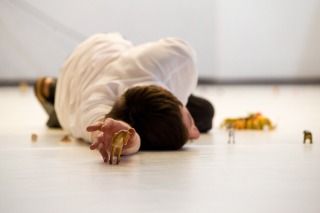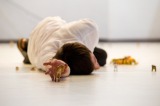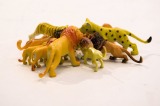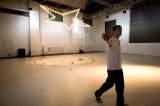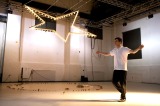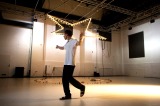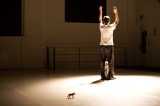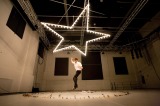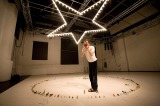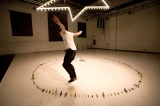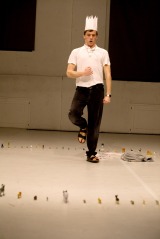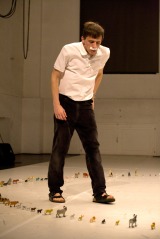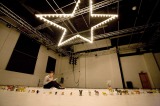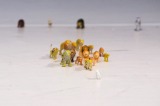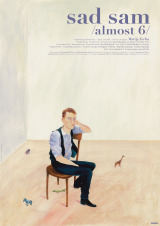About
In his solo performance Sad Sam Almost 6 Matija Ferlin wants to investigate a mind of a child that is not conditioned by anything, not even by his own existence. While growing up, the conscience of the existence creates numerous “terrorizing” facts that are results of social conditions and constraints. All fictitious childhood characters become enemies. The fact that we have to grow up results in imperfections that make our lives and modes of existence specific and individual.
Axioms of the creative process:
A child with no fear! The mind of a kid being conditioned (if at all) only by its existence.
Grow up and kiss terror! The (in)capacity to stop the social terror that transforms childhood naivety into fear of a grown man.
Bring it on man! The will to discuss a certain subject with a lack of arguments.
Now! I have knowledge of my body only by living.
Now 2! Exposure of presence.
This is not a therapy! Creating universal work that is sourced from personal "hard-core" history.
Feelings Suck! Tackling the problematic issues of feelings and emotions that in general view "cannot" be issues of a conceptual work.
Dance - the very last thing! Treating dance as a last necessity to expose certain idea.
We need prophets! Human urge to predict life & death.
Erase Decoration! Forget about the virtuosity and sink down into the functionality of your body.
You are all I need! Since there are no others.
Repetition rules! Indeed.
How to use? Suggest a manual for re-thinking life.
What is this doing here? It was there before you arrived.
Call 911! Performance as the last rescue.
sad sam /almost there ...
-- Matija Ferlin and Katja Praznik
Credits
Created and performed by: Matija Ferlin
Dramaturgy: Katja Praznik
Scenography: Artikl, Silvio Živković
Costums: Artikl
Light design: Urška Vohar, Saša Fistrić
Collaborators: Alexandar Nussbaumer, Mauricio Ferlin, Maja Celija, Maja Delak
Project coordinator: Sabina Potočki
Thanks: all artistic team mentioned above, Andrea, Nikola and his animals, Danijela, Ame, Tqw Stuff, Josip, Max, Mum&Dad, Istarsko narodno kazalište, Senka, Robert, Ivica, Slaven, Aleksandar, Christophe, Kristina, Rhubarb Festival, MPS and to everyone that helped in any way the realization of sad sam /almost 6/.
Support
Produced by: Emanat Institute, Ferlin d.o.o.
Co-produced by: Chez Buswick, New York, Bunker - The Old Power Station Elektro Ljubljana
Financial support: Istria Region, Ministry of Culture RS
Supported by: Tanzquartier Wien & KulturKontakt Austria (artist-in-residence programme)
Media support: Mladina in Radio Študent
Reviews
(...) Convincingly and in places wittily, Matija Ferlin creates a meaningful relationship with the props – the figurines, a relation which can be understood as child play but at the same time also as an ironization of positions within different spiritual groups, ultimately dance workshops, where the teachers and pedagogues conceal their shortcomings, without ever assuming the responsibility for the slippage of their concept. The precise structure and the persuasive suggestibility of the author provoke the impression that the figurines on stage come to life, while the theatre illusion that the fifty-minute long performance is considerably shorter than it actually is certainly indicates that the dance performance Sad Sam is thoughtfully structured.
Delo, February 6 2009, Sad sam/almost 6/, Mojca Kumerdej
(...) The performer’s actions had an effect of child’s play, persistently sliding into social metaphor. The uncounted figurines stood in for the real community (“All you have in common are these actions and this place”), which was controlled and guided by the performer and which was grounded in a common act, such as marching in a circle. This community was also stuck in an in-between space, since it was slit across by the actor’s tendencies for individuation, which is ultimately present in the development of every child. The child growing up in front of us on stage distanced himself from the community in a way that he demanded ample attention from it and pointed out his specificities (he interpreted his favourite song, for example). If one half of the podium suggested social structures, primarily its norms, conventions and especially emphasized strategy of reduction and upbringing, the other, entirely emptied half, lighted by an array of lights (the sun?), represented the field of memory, naked individuality, not yet struck by the society. It represented child’s ontology, expressed through the reminiscence of an adult, who had long time ago experienced a genuine sensual experience. (…)
Dnevnik, February 5 2009, V etično brez blišča, Ana Schnabl
(...) The performer effectively enacts child’s pranks without any virtuosity, which he also eliminates in one of the axioms of his creativity. The games are not at all naive; they are given a creepy subtone because they imitate the fabric of the world of the adult. And it is precisely here where the performance Almost 6 moves – between jocularity and horror, behind which an awareness about the decisive nature of the procedures of personality formation in early childhood – which is so thoroughly thematized in psychoanalytical discourses – can be traced. (…)
Radio Študent, February 3 2009, Dvojna recenzija predstave SAD SAM Almost 6 (Lea & Pia)
You are all what I need! Because there are no others.
Dušan Dovč, (Dusko. D. - Personal archive of art and culture, February 2nd 2009)
(…) I believe Ferlin is a scenic mystic. A dance ascetic with soft movements and mild humour, endlessly mindful of every detail and truly present on the scene. Actually, it is that incredible honesty, being focused on the here and now that draws attention. His most recent solo, Sad Sam / Almost 6, is again different and surprising in the simple intimacy of a child’s play with plastic animal figurines. The first Sad Sam wore the symbol of Saint Sebastian but the first scene in Almost 6 alludes to Saint Francis, who is most frequently represented in iconography as a man talking to animals which surround him. There is something archetypal, ludic in the juxtaposition of the master of play, the one who makes the rules, the mighty creator mundi, with the lovely, naive wittiness of a child at play. Ferlin, astonishing in the point of the situation which takes us by surprise, and capricious in changes, again does not fit within the framework of neither the genre of a dance, drama nor puppet show but he does act on all levels: rational notions, emotional experience and that something in-between which is recognized by the senses are all intertwined(…)
Maja Đurinović, PLESNASCENA.hr, 13th October 2010, Croatia
(…)The conceptual and dance performance consists of two parts – the first one is already being performed while the audience is entering the space. During that time Ferlin, in the role of a teacher, is roll-calling little animals placed around him in a circle. The monotony is broken only by the peculiarity of certain names or some typical remarks about somebody’s absence. The first part uses irony in an intelligent and humorous way to portray the behavior patterns of new age workshops which, apparently, serve to spread conscience and positive energy, to change the individual, but to simultaneously turn them towards each other and towards the world itself. In an elated voice, Ferlin, as a preacher or teacher, is spreading the message, followed by exalted movements taken from the lexis of children’s pretence games. The message conveys ideas about the necessary changes of oneself and then of the entire world, which gets a surreal aura when you cast a glance at his followers, pupils. Exercises which simulate life situations (the situation of a lamb surrounded by wild cats is among the top moments of the performance) follow one after the other, and at one point Ferlin starts singing Radiohead’s All I Need, whose lyrics reveal that we stick to the other person because there is no one or nothing else left for us. Stepping out of the circle of safety, from the defense circle, from the unknown into the known, is the other part of the performance. In it, Ferlin basically goes back to fictitious spaces of his childhood. There was a traumatic, disturbing experience in a vineyard, which left a mark on him even as a grown up. It explains his emotional and psychological profile, a profile of a person who has the role of a helper within the society. We realize that salvation was sought after in the new age ideology because of that trauma and the same is realized by his pupils, who turn their back on him and refuse to admit that their leader is just as vulnerable as they are because such a realization rocks the foundations of the system of values which was based on their previous communication. Rejected by his now lost friends, he sees no other way out but to put those friends in a canvas bag and set off into the world of grown-ups, with which the circle of friendship is closed and the process of pondering about a topic named yuk! in the trailer of the performance by the choreographer himself is started – pondering about problematic issues of feelings and emotions, which are believed to be inappropriate for conceptual work. Sad Sam /Almost 6 is a humorous and charming play with performative genres, a parody of the new age ideology which directs us towards the key issue of the active subject of the society – who are we and why are we who we are. This issue is shrouded with a playful infantilism, topped by sugar so that we could swallow the bitter pill of adulthood more easily (…)
Zrinka Zorčec, Vjesnik, 3rd October 2010, Croatia
(…)The performance which is definitely memorable is Sad Sam / Almost 6, by the Croatian author and performer Matija Ferlin. The piece, covering the subject of emancipation from a child’s world and transfer into the frustrating world of grown-ups, unambiguously wins hearts with its warmth, immediacy, its infantile need to remain in that protected, self-sufficient world at any cost. With a graded and minutely carried out process, from one seemingly careless child’s play, we are skillfully sucked into a far meaner game while witnessing, on the verge of bursting into tears ourselves, that unrelenting moment when that game - whose infinite duration, from a child’s perspective, is the only thing which is never questioned - is made impossible.
Matija Ferlin’s performance is knowledgeable, moving and studied down to the last detail(…)
Milena Jauković, Politika – 11th November 2010, Serbia
(...)The eleventh Platform of Young Choreographers was opened with a performance by Matija Ferlin, an artist who generally draws attention of the audience and critics to himself with his unobtrusive authorial courage, his moves which are unconcerned with fashion and the vocational expectations of the dance scene as well as with his confessional vehemence which reminds us of the immediacy of musical experience. This time Ferlin is performing one of his solos from a series, named Sad Sam / Almost 6. Kneeling within a circle made of minute plastic animals, Ferlin roll calls the members of some undefined community. It might be a dance school, or maybe a communal centre for the socially vulnerable, or a religious group. The performer's comments deliberately leave us perplexed. The only thing which is clear is that the person in the circle, certainly a pedagogue, gives the attendants some instructions and orders, expecting absolute trust from them. As the performance progresses, we realise that the lecturer has something to offer, that his knowledge is great and unusual but the silence of the little animals which are surrounding him is at the same time a sad comment about every autocracy: no participation, no answer, no co-creativity.
Sad Sam / Almost 6 asks itself and the audience the questions on what it really means to teach somebody spiritual and physical expressiveness, what it means to form around yourself a circle of followers and how to withstand an educational situation in which every open knowledge becomes just a formula and an instruction for performing, about which there is no discussion. After having been schooled in Amsterdam, and after having worked on stages and in really prestigious companies in Germany, USA, Canada, Romania, Portugal, the Netherlands, Slovenia, Serbia, Hungary and Austria, Ferlin definitely does know what he is talking about when he brings up the topic of violence of the lecturing drill. Only one little horse manages to step out of the closed circle of obedience and remain on stage just like, for a brief moment, Matija Ferlin manages to step out of his role of a tyrannous pedagogue and starts sharing with us his memory of a childhood day, when he was about six, and he was running with open arms in his vineyard in Istria. It is interesting that the performance of the memory of freedom seems far stronger than all the things happening within the circle, as if the whole life of an author can be built on an ecstatic moment, and not on a number of years spent on professional development and teaching.
The audience watched the performance in deep, introspective silence, which was followed by a long and warm applause. The first answer to the question What is a choreographer?, which this year’s Platform of Young Choreographers asks its audience every day (and one can also see it on posters throughout the city), could be given with Ferlin's help. A choreographer is a person who steps out of the circle of an arranged discipline and, at the cost of worldwide fame, does not renounce the truth of their body, the truth of their emotional memory(...)
Nataša Govedić, Novi list, 4th October 2010, Croatia
(... )Sad Sam / Almost 6 by Matija Ferlin starts from childhood innocence which, with society-induced mechanisms, turns into fears, thus conditioning the illness of the society as a whole. By surrounding himself with plastic figures of little animals and placing himself in the centre, Ferlin, along with dramatist Katja Praznik, inquires into the mechanisms with which the infantile and narcissistic focus on play is copied onto the strategy of leaders, no matter whether they are leaders of a herd, politically prominent figures, spiritual gurus or simply tutors of a dance workshop. Relations are established between individuals who create a mass, as well as between every individual and the leader. Within the mass, the individuals feel equal because they are joined together by their relationship with the leader. On the other hand, the leader establishes relations only towards himself, he values and exalts only himself. By stepping out of the circle and leaving the central position to somebody else, Ferlin accentuates the complex structure of society, its endless stratification. By crushing the reality in this way, the boundaries between the subordinate and the superior are being blurred because everyone finds themselves in the leading position at a certain point in life(...)
Ivana Slunjski, Matica Hrvatska, 21th October 2010, Croatia
(…) Sad Sam / Almost 6 by Matija Ferlin (author, choreographer and performer) is an impressive art play which, along with the great performance and lightness of movements, touches the spectator with honesty, warmth, some mild energy, which ranges from a child's joy and bliss to silent melancholy and sadness…
Ferlin starts his danced and acted out story, enriched with associations, fine irony and becoming humour, while the audience is still entering the auditorium. On a white stage, under the white light of a star made of little light bulbs, he is roll-calling (in English) his pupils, international attendants of a course after which nothing will ever be the same. The pupils are played by little plastic animals of all colours and kinds. They are all there, placed in a circle around their tutor. And Jonatan, and Mauro, and Roberto, and Branko, and Vincenzo, and Seraphina, who is celebrating her birthday, and Modesto, and Ignacio, and Diana… A total of 126, among which there are seven new ones. Because of the immediacy, naturalness and the way in which Ferlin communicates with them, the animals become alive on stage. It is the true illusion of theatre. All this in a performance whose set design ends up fitting in one white nylon bag with which, in the end, the artist leaves the stage alone. The only thing remaining is the little horse Modesto, which had to turn its back to the group. And which ended up seeing nothing anymore. Although it should have.
In a one-hour story, Ferlin juxtaposes a pure mind of a child with scenes of the grown-ups' world. A leader, a king, a belly dancer are born with movements, voice, music, and with a small paper detail, which becomes a costume on stage. There are also childhood memories, which in Sad Sam / Almost 6 refer to the concept of time: the recalled scene from the children’s game Granny, granny, what’s the time? and the memory of a time when the trace of a child’s own bite on their arm represented a watch which was telling the exact time. The latter scene should definitely be singled out as the most lyrical scene of the play. The strong, rounded white light is also scenically powerful. Juxtaposed with shaded parts, it symbolizes pure, open thought.
While Ferlin has already enchanted us with his dance skills, with Sad Sam / Almost 6 he is now presenting himself as a mature author and choreographer. His latest project features a clear and rounded concept and explicit dramaturgy (Katja Praznik)…”
Bojana Čustić Juraga, GLAS ISTRE, 30th April 2009, Croatia
12.07.2012, Giovanni critici, Santachangelo, IT
21.07.2012, Il gesto parlante di Matija Ferlin, with Matteo Vallorani (in collaboration with Francesca Bini, Ines Baraldi, Michelle Davis), Santarcangelo, IT
09.11.2012, Bagnolet danse encore plus a l'Est, Liberation, FR
15.07.2012, L'ombre dell'infancia di Matija Ferlin, Corriere Romagna, Serena Marcelli, IT
03.04.2013, Sad Sam Almost 6. Matija Ferlin verso una ripettizione parfetta, Krapp's last post, Ines Baraldi, IT
16.04.2013, Performances avec un S, Mouvement.net, Gerard Mayen, FR
23.06.2015, Comedy Central, El Centro Pompidou de París dedica un especial al Stand-up
08.07.2015, Czech Dance Info, International festival Zero Point - Guests from 6 counties
14.07.2015, Divadelní Noviny, Žhavé setkání s fyzickým divadlem (No. 2), Dominik Melichar
15.07.2015, Taneční Aktuality, Nultý bod 2015: Návrat Smutného Sama na festival Nultý bod 2015, Tereza Kosáková
29.09.2015, Sad Sam Almost 6 di Matija Ferlin riporta l’infanzia a teatro, D'ars Magazine, Simone Azzoni
21.01.2017, Le parole sincere, On Stage, Zoraide Cremonini
21.01.2017, Sad Sam Lucky, CSS Udine
21.01.2017, Matija Ferlin, performer croato a teatro Contato, Danza & Danza Web, Elisabetta Ceron
21.01.2017, Matija Ferlin: Danza alleorigini dell'infanzia, Cultura
23.01.2017, Matija e i 126 toys che incarnano le nostre paure, Messagero de lunedi, Elisabetta Ceron
Previous events
- , MOT, Non-aligned movement, Skopje, MK
- , GK Zorin dom, Karlovac, HR
- , SMEEL, Ljubljana, SI
- , Zoom Festival, HKD na Sušaku, Rijeka, HR
- , Teatro Stabile, Udine, IT
- , NAOCREA 2015, Milano, IT
- , We Are Human Festival, Verona, IT
- , The Zero point 2015, Prague, CZ
- , ZPC, Zagreb, HR
- , Centre Pompidou, Paris, FR
- , Centre Pompidou, Paris, FR
- , Centre Pompidou, Paris, FR
- , Festival Transamerique, Montreal, CA
- , Festival Transamerique, Montreal, CA
- , La Bâtie-Festival, Genève, CH
- , La Bâtie-Festival, Genève, CH
- , TAP - Théâtre Auditorium de Poitiers, FR
- , TAP - Théâtre Auditorium de Poitiers, FR
- , Teatro Studio, Firenze, IT
- , Teatro Studio, Firenze, IT
- , DANSEM 2012, Marseilles, FR
- , DANSEM 2012, Marseilles, FR
- , Le Colombier, Bagnolet, FR
- , Le Colombier, Bagnolet, FR
- , Le Colombier, Bagnolet, FR
- , Santarcangelo Festival, Santarcangelo, IT
- , Santarcangelo Festival, Santarcangelo, IT
- , Santarcangelo Festival, Santarcangelo, IT
- , CCN, Caen, FR
- , Black Box, Oslo, NO
- , Black Box, Oslo, NO
- , Dansfabrik, Le Quartz, Scene National, Brest, FR
- , Muzej suvremenih umjetnosti, Hrvaška plesna platforma, Zagreb, HR
- , Balkan Dance Platform, SMEEL, Ljubljana, SI
- , Gibanica, Kino Šiška, Ljubljana, SI
- , Kondenz, Stanica, Beograd, RS
- , Muzej suvremenih umjetnosti, Platforma mladih koreografa, Zagreb, HR
- , Plesni teater Ljubljana, SI
- , Plesni teater Ljubljana, SI
- , X-YU Festival, The Dixon Place, New York, US
- , X-YU Festival, The Dixon Place, New York, US
- , X-YU Festival, The Dixon Place, New York, US
- , INK, Pula, HR
- , Stara mestna elektrarna, Elektro Ljubljana, SI
- , Stara mestna elektrarna, Elektro Ljubljana, SI
